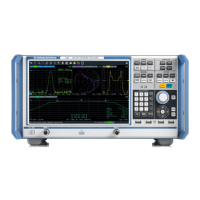Concepts and Features
R&S
®
ZNB/ZNBT
111User Manual 1173.9163.02 ─ 53
●
Points with the same reactance produce arcs.
The following example shows a Smith chart with a marker used to display the stimulus
value, the complex impedance Z = R + j X and the equivalent inductance L.
Smith chart construction
In a Smith chart, the impedance plane is reshaped so that the area with positive resist-
ance is mapped into a unit circle.
The basic properties of the Smith chart follow from this construction:
●
The central horizontal axis corresponds to zero reactance (real impedance). The
center of the diagram represents Z/Z
0
= 1 which is the reference impedance of the
system (zero reflection). At the left and right intersection points between the hori-
zontal axis and the outer circle, the impedance is zero (short) and infinity (open).
●
The outer circle corresponds to zero resistance (purely imaginary impedance).
Points outside the outer circle indicate an active component.
●
The upper and lower half of the diagram correspond to positive (inductive) and
negative (capacitive) reactive components of the impedance, respectively.
Example: Reflection coefficients in the Smith chart
If the measured quantity is a complex reflection coefficient Γ (e.g. S
11
, S
22
), then the
unit Smith chart can be used to read the normalized impedance of the DUT. The coor-
Screen Elements

